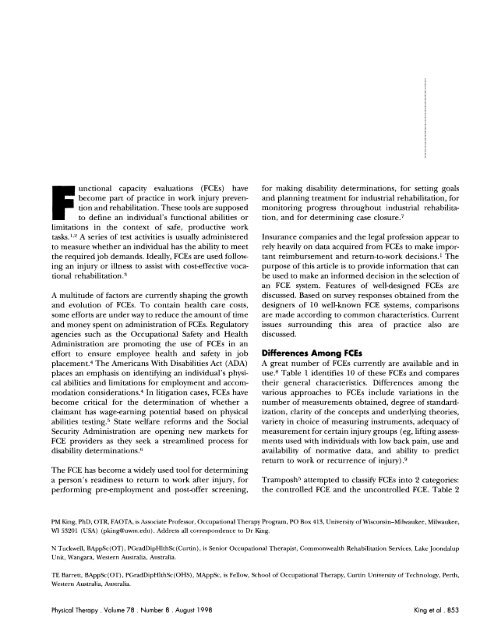A Critical Review of Functional Capacity ... - Physical Therapy
A Critical Review of Functional Capacity ... - Physical Therapy
A Critical Review of Functional Capacity ... - Physical Therapy
You also want an ePaper? Increase the reach of your titles
YUMPU automatically turns print PDFs into web optimized ePapers that Google loves.
unctional capacity evaluations (FCEs) have<br />
become part <strong>of</strong> practice in work injury preven-<br />
tion and rehabilitation. These tools are supposed<br />
to define an individual's functional abilities or<br />
limitations in the context <strong>of</strong> safe, productive work<br />
tasks.1,:! A series <strong>of</strong> test activities is usually administered<br />
to measure whether an individual has the ability to meet<br />
the required job demands. Ideally, FCEs are used follow-<br />
ing an injury or illness to assist with cost-effective voca-<br />
tional rehabilitation.^<br />
A multitude <strong>of</strong> factors are currently shaping the growth<br />
and evolution <strong>of</strong> FCEs. To contain health care costs,<br />
some efforts are under way to reduce the amount <strong>of</strong> time<br />
and money spent on administration <strong>of</strong> FCEs. Regulatory<br />
agencies such as the Occupational Safety and Health<br />
Administration are promoting the use <strong>of</strong> FCEs in an<br />
effort to ensure employee health and safety in job<br />
place~ment.~ The Americans With Disabilities Act (ADA)<br />
places an emphasis on identifying an individual's physical<br />
abilities and limitations for employment and accommodation<br />
consideration^.^ In litigation cases, FCEs have<br />
become critical for the determination <strong>of</strong> whether a<br />
claimant has wage-earning potential based on physical<br />
abilities te~ting.~ State welfare reforms and the Social<br />
Security Administration are opening new markets for<br />
FCE providers as they seek a streamlined process for<br />
disability determinations."<br />
The FCE has become a widely used tool for determining<br />
a person's readiness to return to work after injury, for<br />
performing preemployment and post-<strong>of</strong>fer screening,<br />
for making disability determinations, for setting goals<br />
and planning treatment for industrial rehabilitation, for<br />
monitoring progress throughout industrial rehabilita-<br />
tion, and for determining case cl~sure.~<br />
Insurance companies and the legal pr<strong>of</strong>ession appear to<br />
rely heavily on data acquired from FCEs to make impor-<br />
tant reimbursement and return-to-work decisions.' The<br />
purpose <strong>of</strong> this article is to provide information that can<br />
be used to make an informed decision in the selection <strong>of</strong><br />
an FCE system. Features <strong>of</strong> well-designed FCEs are<br />
discussed. Based on survey responses obtained from the<br />
designers <strong>of</strong> 10 well-known FCE systems, comparisons<br />
are made according to common characteristics. Current<br />
issues surrounding this area <strong>of</strong> practice also are<br />
discussed.<br />
Differences Among FCEs<br />
A great number <strong>of</strong> FCEs currently are available and in<br />
use.8 Table 1 identifies 10 <strong>of</strong> these FCEs and compares<br />
their general characteristics. Differences among the<br />
various approaches to FCEs include variations in the<br />
number <strong>of</strong> measurements obtained, degree <strong>of</strong> standard-<br />
ization, clarity <strong>of</strong> the concepts and underlying theories,<br />
variety in choice <strong>of</strong> measuring instruments, adequacy <strong>of</strong><br />
measurement for certain injury groups (eg, lifting assess-<br />
ments used with individuals with low back pain, use and<br />
availability <strong>of</strong> normative data, and ability to predict<br />
return to work or recurrence <strong>of</strong> injury) .g<br />
Tramposh5 attempted to classify FCEs into 2 categories:<br />
the controlled FCE and the uncontrolled FCE. Table 2<br />
PM King. PhD, OTR, FAOTA, is Associate Pr<strong>of</strong>essor, Occupational <strong>Therapy</strong> Program, PO Box 413, University <strong>of</strong> Wisconsin-Milwaukee, Milwaukee,<br />
Wl 53201 (USA) (pkingBuwm.edu). Address all correspondence to Dr King.<br />
N Tuckwell, BAppSc(OT), PGradDipHlthSc(Curtin), is Senior Occupational Therapist, Commonwealth Rehabilitation Services, Lake Joondalup<br />
Unit, M'angara, Western Australia, Australia.<br />
TE Bari-ett, BAppSc(OT), PGradDipHlthSc(OHS), MAppSc, is Fellow, School <strong>of</strong> Occupational <strong>Therapy</strong>, Curtin University <strong>of</strong> Technology, Perth.<br />
Western Australia, Australia.<br />
<strong>Physical</strong> <strong>Therapy</strong> . Volume 78 . Number 8 . August 1998 King et al . 853
















